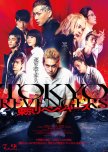A Worthwhile Adaptation…
Adapting a popular manga and anime series to a live-action movie can be a case of trial and error with attempting to appease newcomers and fans alike rarely ending in overall success. Nevertheless Tsutomu Hanabusa and Izumi Takahashi decided to take on the challenge of mangaka Ken Wakui’s popular series ‘ Tokyo Revengers’ to the big-screen with an adrenal-infused movie that delivered all of the franchise’s punches and blows.
Akin to its original source material the movie focused upon deadbeat " loser" Takemichi Hanagaki ( Takumi Kitamura). At twenty -six years old and stuck in a job that he absolutely loathes with the passion , Hanagaki soon comes to the conclusion that he’s reached a stalemate with life-given opportunities . However fate has other plan for the unlikely hero.
Hanagaki stumbles upon the revealed truth that his ex-girlfriend Tachibana Hinata ( Mio Imada) perished at the hand of the notorious Tokyo Manji Gang. When Hanagaki is given a golden-opportunity to travel back in time to save his former-girlfriend from her violent death, Hanagaki becomes determined to do whatever it takes to save Hinata. The " crybaby hero" is forced to befriend the Manji group’s unlikely leader Mikey"( Yoshizawa Rio), and his right-hand man " Draken" ( Yamada Yuki) as he attempts to infiltrate the gang and prevent domino- effect -events from occurring through his timeline. However as Takemichi works together with Hinata’s younger brother and detective Tachibana Naoto ( Sugino Yosuke),Takemichi’s life begins to diverge in new directions as he dives deeper into the underworld of delinquents…
Tokyo Revengers’ has always had a “ love-hate” relationship with fans and enthusiasts alike. Whilst many have praised mangaka Ken Wakui’s popular series for its intriguing setup and characters, the series has always hit a rut with audiences over two notable flaws : the believability of its ensemble of teen characters actually acting and being their age, as well as the plot holes and loops which remain greatly prominent in the manga writer’s well-known work. In many ways Takahashi and Hanabusa are subtly decisive within the included elements in their adapted live-action movie.
Of course the director and screenwriter are careful not to stray too far away from the source material. On the other hand subtle changes can become prominent to audiences through certain directions of the storyline and especially with consideration to the age of the characters. Takahashi presented the characters as slightly older than their original counterparts; arguably resonating with audiences by the complex journey of adolescence reflected through the allegorical harshness of reality and experiences onscreen.
Paired together with Takahashi’s kaleidoscope of eclectic genres from mystery to action and then romance, there’ s a gritty-edge to Hanabusa’s focus upon fight scenes which add a notable focus upon violence throughout the movie.
Although silly and lighthearted gags transcended onto the big-screen from Wakui’s manga in order to lighten up heavy-angst and fist fights, Hanabusa downplayed comic relief a lot in his adaptation. Instead the movie’s pacing could feel heavily impacted by the blows and fists of its onscreen characters. The elements of comedy which heavily dominated Wakui’s work against darker panels were sparingly dispersed throughout the film; necessary padding at times but gradually beginning to unravel the storyline’s loose-ends.
As the film’s narrative progressed it became evident to audiences that there was an evident disparity in fight scenes. Arguably Hanabusa’s defence against main lead Takemichi Hanagaki being a visible weakling who is often beat up is excusable to a certain extent as he’d rarely escape from a fight or brawl scene unmarked. Nevertheless there was an unintentional farcical element as the storyline progressed with the contrast between realistic physical strength amongst those engaged in the action soon growing clearly visible for audiences.
Of course Hanabusa wasn’t entirely devoid of coherency when attempting to film the fight scenes of the movie. Together with the help of Tomo Ezaki , there was something surprisingly pacy about stunning visuals coinciding against emotional punches especially as the climax began to arise. However the movie’s climax did help to mark drawing up the fight for audiences, the delivered result of aesthetic and visual brawl sequences could often feel like a coated exterior to draw attention away from the anticlimactic buildup of initial events and the delivered result.
Another element of the movie which arguably suffered under the restraints of pacing was the romantic relationship between Hinata and Takemichi. It is arguable that Hanabusa did not entirely abandon the onscreen relationship between the main lead and his former-girlfriend as this did arguably remain one of the greatest-driving forces for the storyline and Takemichi’s personal goals. On the other hand it could often feel as though Hanabusa used the romantic element of ‘ Tokyo Revengers’ as merely padding once again again the violence of the series; necessary for framing the storyline and plot-drive but rarely shaping out the relationship and complexities for Hinata and Takemichi with more definitive edges.
Then of course there’s the discussion surrounding the casting choices of our main leads. Whilst there were admittedly a few scenes where audiences had to power through certain wooden line deliverances, it’s undeniable that Kitamura is brilliant as Takemichi. The actor managed to bring out the awkward charm of Hanagaki’s adult-self navigating his past against his rekindled courage and determinism which gradually awakens through Kitamura’s subtle yet profound micro-expressions and intonations. Costarring with Kitamura are Ryo Yoshizawa as Mikey and Yuki Yamada as Draken are astounding in their roles by adding an idiosyncratic ambience to their onscreen personas that is both heartwarming and threatening.
Then there’s Mio Imada as Takemichi’s former-lover. Whilst Imada’s screen time is restricted due to her character’s limited scream appears des , her performance did offer a level of sweet and dynamic charm to her embodied role as Hinata and carried through with natural chemistry towards her costar Kitamura.
The vision of Hanabusa’s work was aesthetic for audiences but admittedly without a few flaws. Exploration into Takemichi’s reasons for time-travelling and the handshake being the ultimatum are left hanging the air in the movie’s tight-paced storyline. Additionally there were often few transgressions ( aside from haircuts and technology) made between the past and present eras for the audience. Whilst it would’ve been ridiculous for the series to have nuanced each time-leap in depth there were certainly a multitude of missed-out opportunities to explore a manipulation of cinematography. This could’ve easily been done in order to highlight a greater sense of pathos and nostalgia by Takemichi as an adult experiencing his youth once more. Despite this the ending delivered audiences with a fairly satisfying and outcome to the events of the movie.
Hanabusa and Takahashi’s adapted live-action movie was an evident challenge from the outset. Whilst the movie is evidently limited to a certain extent carried on by noted flaws from Wakui’s work as well as the director and screenwriter’s own directions having their strengths and limits. Nevertheless ‘ Tokyo Revengers’ was a fairly satisfying and adrenal-ride; pacy at times and slightly tedious in other parts, but engaging and intriguing through its cast and setup tone by Hanabusa and Takahashi.
Vond je deze recentie nuttig?
























